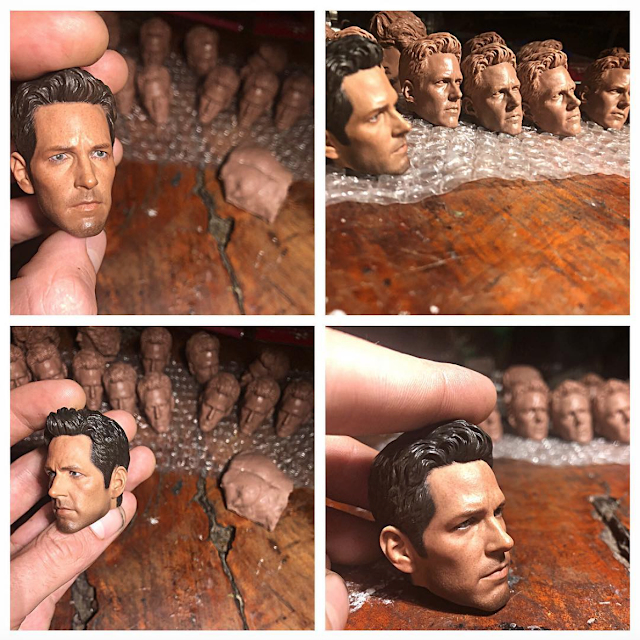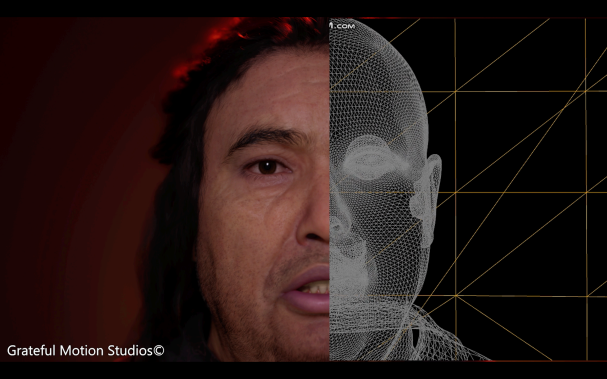Featured Animator: Harrison Killian Fuses Sculpture, CGI, and Stop Motion to Blur the Line Between Animation and Reality
 |
| Harrison Killian sculpting a character head for his animated short, Rider on the Storm. |
Residing on a mountaintop in Liberty, located in the Catskill Mountains of New York, and primarily self-taught, Harrison Killian is a musician, sculptor, animator, and the founder of Grateful Motion Studios which is currently producing an independent animated short film, ‘Rider On The Storm.’
The film uses Harrison's, groundbreaking, animation technique that fuses the artistry of stop-motion with the precision of CGI, creating imagery that blurs the line between reality and animation, leaving audiences questioning if what they saw was animated or real.
'Rider On The Storm' is culled from a feature-length screenplay written by Harrison that received high industry scores, landing it on the Red List on Coverfly. Written to evoke emotions and inspire imaginations, the story is about a boy named Rider who is orphaned at seven and endures a childhood of bullying by other orphans and abuse at the hands of a Head Matron. At seventeen Rider finally stands up to the biggest bully and then, facing the wrath of the Head Matron, makes a run for it, unaware that his actions have left one person dead and jeopardized his future.
Harrison has produced numerous stop-motion/claymation animated films. A previous claymation animated short, ‘Dream With Me’ was screened 20 film festivals globally winning several awards, including Mill Valley and Catalina.
 |
| Festivals and Awards for 'Dream With Me' an animated short by Harrison Killian. |
The animated claymation Harrison used previously is primitive in comparison to the technique developed to produce ‘Rider On The Storm’. The ability to capture human emotion with figures made of clay resulted in the global recognition received by ‘Dream With Me’ which is available on Amazon Prime.
Animation Technique
My knowledge of human anatomy and movement enables me to create characters that are incredibly lifelike. Each character, body and head, are 1:6 scale, hand-sculpted, molded, and cast in silicone over a ball and socket armature that acts as a skeleton. Attention to detail ensures that the characters articulate seamlessly. The silicone, with its skin-like texture, mimics the displacement and wrinkling of real skin, adding to the realistic illusion.
To create realistic heads, I start by sculpting the characters from scratch. I then make a mold and cast a polyurethane copy of the head. I 3D scan the heads with a Nikon D5500 using a technique known as photogrammetry where 1000s of images of an object are linked together similar to a panorama.
 |
| Highly detailed character heads sculpted by Harrison. |
I use Blender, the open source 3D software, to transfer the sculpt into digital mesh form, subdividing the geometry for more detail, and sculpting pore level details into the digital model. This level of detail can only be achieved with millions of polygons requiring a very high end computer. The hair is also created and sculpted from scratch digitally.
Using my knowledge of color zones in a face, I paint the skin realistically. The textures are either sculpted, then baked (combined so they can no longer be edited separate from the mesh) into the mesh or baked from procedural textures created with nodes (data blocks that can be linked together each with instructions/settings for modifying the information fed into them). After baking various types of high detail information into the maps, you can combine them using nodes to alter the appearance or functionality of an object.
I then create an advanced rig for the face.
 |
| Cross-section showing an underlying wire mesh used in Harrison's CGI characters. |
For each portion of the face that has lines and wrinkles such as brow, smile, and crows feet, I must sculpt each expression into the mesh. I then create a key that can toggle said expression allowing me to animate the face with any conceivable movement. Using an advanced series of nodes, I create a functioning human face with a corresponding rig that allow me to control the movement of the face.
The body is animated completely with stop-motion animation, an advanced flip book style form of animation. It involves photographing and then physically manipulating objects within your frame. As each frame is played in sequence, the technique creates the effect of an object moving itself.
Back to hand sculpting, I sculpt the bodies and make a 2 part mold of them. This allows me to place a ball and socket armature inside the mold. I then fill both sides of the mold and squish them together. Once the silicone has cured, the resulting body is a realistic fully articulating 1:6 scale body ready for animation with the armature inside.
 |
| Body molds created by Harrison. |
With both CG face and stop-motion body layers animated, I use Mocha Pro, an advanced planar tracking software, to fuse the two animation layers together. To match the lighting of these two shots, I use a Ricoh Theta 360 camera to capture the exact lighting of the miniature sets.
For shots that aren’t close up such as wide angle I paint the polyurethane head casting and punch real hair. Not only are these characters digital, there is a physical model being used for the body animation.
I edit the final shots on Final Cut Pro or Adobe Premiere using either Mac or Windows.
Inspiration
Harrison draws inspiration from pioneers of stop-motion animation like Will Vinton, Henry Selick and Ray Harryhausen. Filmmakers Tim Burton and Wes Anderson have also inspired the studio’s creative approach to animation, with their unique aesthetics and compelling narratives.
The music of The Doors also plays a significant role in driving the narrative of ‘Rider on the Storm’, connecting music and film seamlessly.
Biggest challenges
Grateful Motion Studios was founded in 2017 and is determined to ensure that Harrison's vision remains intact throughout the filmmaking process. The groundbreaking approach to animation sets a new standard for storytelling, blurring the lines between reality and animation, combining a captivating story with stunning visuals handcrafted for the silver screen.
As with all independent films, raising funding for a production is one of the biggest challenges. Harrison has launched a Kickstarter for this purpose. The behind the scenes clips and Kickstarter introduction video shows what has been accomplished thus far with no outside funding.
Your contribution can play a pivotal role in launching this groundbreaking project. Whether by making a donation or simply sharing the campaign with your friends and family, every bit of help counts. In recognition of your support, Grateful Motion Studios will honor you with a shoutout on the official film page.
Follow the links below for information about the Kickstarter and to see more of this mind blowing animation technique. When you begin to watch the introductory video ask yourself if the person talking is real or animated? What about afterwards? Become a part of this pioneering project with your feedback, a donation, or just a share, and help Harrison's quest to redefine the boundaries of animation.
LINKS:
‘Rider On The Storm’ Animated Short Film - Kickstarter Page
Realistic Female Sculpture - Video of Harrison Sculpting a Female Head.
Jim Morrison Realistic Face Sculpture - Video of Harrison Sculpting Jim Morrison Head.
Future plans
The goal for Grateful Motion Studios is to produce the feature-length version of ‘Rider on the Storm.’ The innovative animation technique, a fusion of stop-motion and CGI, will be showcased in the short film version of ‘Rider on the Storm’ and will serve as a teaser and marketing tool for the feature-length production.
The studio is poised for success with a growing following of supporters and potential investors. The goal is to either direct and produce the feature in-house or collaborate with an established studio that is willing to preserve the vision behind the screenplay.
Beyond this project, the studio has a pipeline of captivating screenplays ready for production, promising a bright future for Grateful Motion Studios.
Post Credits:
Written by: Harrison Killian
Edited: David Arandle
Images: Harrison Killian.

Comments
Post a Comment
This blog is monitored by a real human. Generic or unrelated spam comments with links to sites of dubious relativity may be DELETED.
I welcome, read, and respond to genuine comments relating to each post. If your comment isn't that save me some time by not posting it.